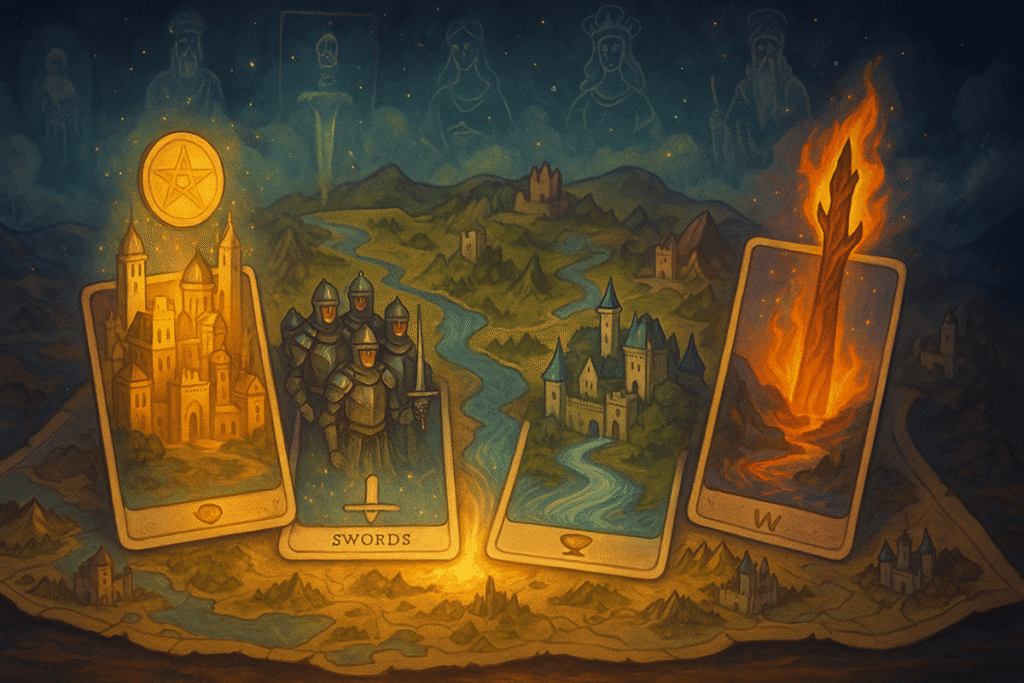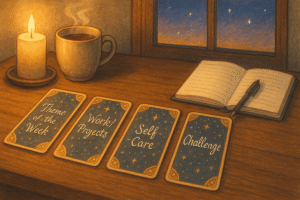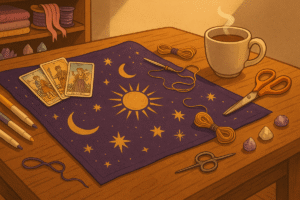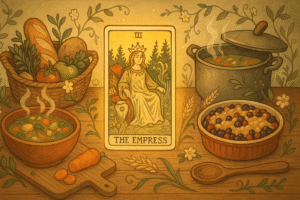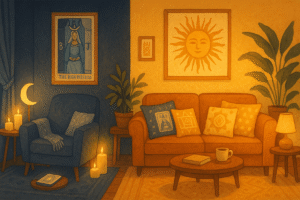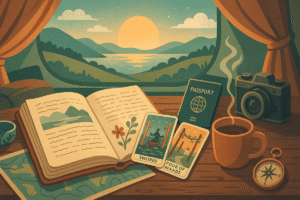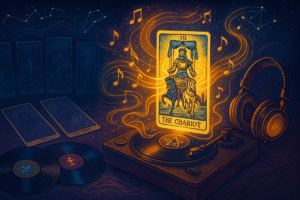Table of Contents
Have you ever stared at a blank page, wondering how to breathe life into an imaginary world? I think most writers and game masters have been there. The cursor blinks mockingly while we search for that perfect detail that will make our fictional realm feel authentic and lived-in.
What if I told you that a simple deck of tarot cards could unlock doorways to entire civilizations? Perhaps this sounds unusual at first, but tarot has quietly become one of the most versatile creative tools available to storytellers. The rich symbolism and archetypal imagery contained within these 78 cards offer an endless wellspring of inspiration for world-building.
When we approach tarot as a creative catalyst rather than a mystical oracle, something remarkable happens. Each card becomes a mirror reflecting back possibilities we might never have considered. The Hermit doesn’t predict a lonely future; instead, it might inspire you to create a culture of scholarly monks who preserve ancient knowledge in mountain monasteries.
This approach to using tarot for world-building has transformed how many writers and dungeon masters develop their fictional settings. Instead of relying solely on familiar fantasy tropes, we can tap into the collective unconscious that tarot represents, discovering fresh perspectives and unexpected connections.
Understanding the Foundation
Before diving into specific techniques, it’s worth exploring why tarot works so effectively for creative endeavors. The deck operates on multiple symbolic layers, each offering different entry points for inspiration. The Major Arcana tells the story of a journey from innocence to wisdom, while the Minor Arcana explores the practical aspects of daily life through four distinct lenses.
I’ve noticed that when writers first experiment with tarot for world-building, they often feel overwhelmed by the possibilities. This is perfectly natural. The key lies in approaching each card not as a rigid definition, but as a starting point for your imagination. Think of each image as a conversation starter rather than a final answer.
The beauty of this method emerges when we recognize that every fictional world needs both grand mythological elements and intimate cultural details. Tarot provides both. The Tower might inspire the catastrophic event that reshaped your world’s geography, while the Three of Cups could spark ideas about how different communities celebrate important milestones.
The Four Realms Spread
Let me share one of my favorite techniques for establishing the basic framework of a new world. The Four Realms Spread uses one card from each suit to create distinct cultural regions or kingdoms within your setting.
Start by shuffling your deck and drawing one card from each suit. Don’t overthink this process; sometimes the most unexpected combinations yield the most interesting results. Perhaps you’ll draw the King of Pentacles, Seven of Cups, Two of Swords, and Page of Wands. Each card now represents a different realm with its own character and focus.
Your Pentacles realm might embody material prosperity and practical wisdom. Picture a nation of skilled craftspeople and successful merchants, where innovation flows from necessity and trade routes connect distant lands. The King suggests established authority and proven leadership, so perhaps this realm is governed by a council of master artisans rather than hereditary nobles.
The Cups realm, represented by the Seven of Cups, could be a land where dreams and emotions hold tangible power. Maybe illusions shimmer in the air during certain seasons, or the people have developed sophisticated emotional intelligence as a survival skill. This realm might value artists, dreamers, and those who can navigate the subtle currents of feeling that others cannot perceive.
I find that the Swords realm often surprises people with its complexity. While many assume it represents only military might, the Two of Swords suggests a culture grappling with difficult choices and balanced tensions. Perhaps this realm exists in a constant state of philosophical debate, where intellectual prowess matters more than physical strength, and every citizen must master the art of reasoned argument.
The Wands realm, embodied by the Page of Wands, pulses with youthful energy and untamed potential. This could be a frontier society where exploration and adventure drive cultural values. New discoveries happen regularly, and the people celebrate bold initiatives even when they don’t always succeed.
Mythological Foundations Using Major Arcana
The Major Arcana cards offer profound archetypal energies that can form the mythological backbone of your world. These aren’t just creation stories; they’re the deep currents that shape how your fictional cultures understand existence itself.
Consider drawing three Major Arcana cards to represent your world’s creation myth, its greatest catastrophe, and its hoped-for future. This creates a temporal framework that influences everything from religious practices to political structures.
If you draw The Empress for creation, your world might have emerged from an act of abundant creativity rather than cosmic violence. Perhaps the very landscape reflects this nurturing origin, with unusually fertile lands and creatures that display remarkable cooperation rather than constant competition.
The Devil as your catastrophic event doesn’t necessarily mean literal demons invaded. It could represent a time when your civilizations became trapped by their own limiting beliefs or destructive patterns. Maybe an age when technological advancement outpaced wisdom, leading to environmental devastation or social collapse.
Temperance as the future hope suggests a world striving toward balance and integration. Your cultures might share a common belief that their ultimate destiny involves learning to harmonize opposing forces, whether that’s magic and technology, different species, or competing philosophical systems.
These mythological foundations create narrative threads that can weave through every aspect of your world-building. Religious ceremonies, architectural styles, legal systems, and even casual expressions in daily conversation can all reflect these deeper mythological currents.
Cultural Depth Through Minor Arcana
While Major Arcana provides the grand mythological structure, the Minor Arcana cards excel at generating the intimate cultural details that make a fictional world feel authentic. Each suit offers a different lens for exploring how your imagined societies function.
The progression from Ace to King within each suit can represent different social structures or life stages within a culture. In your Wands-influenced realm, perhaps citizens advance through clearly defined ranks based on their contributions to exploration and discovery. An Ace of Wands individual might be someone just beginning their first expedition, while a Queen of Wands could be a renowned explorer who now guides others’ journeys.
Pentacles progressions might reflect economic or craft-based hierarchies. The artisan who creates their first masterwork (Ace of Pentacles) eventually develops into the master craftsperson who trains the next generation (King of Pentacles). But what happens to those who plateau at the Seven of Pentacles, constantly evaluating their progress without quite achieving mastery?
I think these questions matter because they create realistic social tensions and individual motivations that enrich your storytelling. Not everyone in your fictional world should be a hero or a villain; most people exist somewhere in the middle, navigating their personal journeys within larger cultural frameworks.
The court cards deserve special attention as potential character archetypes or social roles. The Knight of Swords might represent a specific military position in your Swords realm, complete with unique training methods and cultural expectations. But in your Cups realm, this same archetype could manifest as someone who fights emotional battles, perhaps a mediator who helps resolve community conflicts through empathy and understanding.
Historical Timeline Development
Creating a believable history for your fictional world can feel daunting, but tarot offers a structured approach that generates both major events and their cultural consequences. Try drawing a series of cards to represent different historical eras, allowing each card to suggest not just what happened, but how it shaped the world’s development.
Perhaps your world’s ancient period draws The Hierophant, suggesting an age when organized religion or traditional knowledge systems dominated social structures. This era might have established the philosophical foundations that still influence your cultures, even if they’ve evolved or rebelled against those original teachings.
A classical period represented by the Chariot could indicate a time of great expansion and conquest, when your various realms first encountered each other through trade or conflict. The cultural exchanges during this period might explain why certain traditions appear in multiple regions, or why some realms maintain deep suspicions about their neighbors.
The Tower appearing in your medieval period suggests a time of dramatic upheaval that nobody saw coming. This could be a natural disaster, a magical catastrophe, or a social revolution that completely reshaped political boundaries. The important question becomes not just what fell during this period, but what new possibilities emerged from the chaos.
Sometimes I draw additional cards to explore the consequences of major historical events. How did different cultures adapt to the changes? Which traditions survived, and which ones transformed beyond recognition? These layers of historical complexity create the kind of rich background that makes fictional worlds feel substantial and lived-in.
Integrating Magic Systems and Technology
If your world includes magical or technological elements, tarot can help you develop systems that feel organic rather than arbitrary. Each suit suggests different approaches to power and problem-solving that can inform how your cultures relate to extraordinary abilities.
A Pentacles-influenced approach to magic might emphasize practical applications and measurable results. Perhaps their spellcasters function more like engineers, using precise calculations and tested procedures to achieve reliable effects. Their magical items might be sturdy, functional tools rather than ornate artifacts.
Cups-based magic could operate through emotional resonance and intuitive understanding. These practitioners might need to genuinely feel compassion to heal others, or maintain inner harmony to work with water and weather. Their training would emphasize emotional intelligence and empathy as much as technical skill.
The relationship between different magical or technological traditions can create interesting tensions within your world. Maybe the precise Pentacles approach conflicts with the intuitive Cups method, leading to academic debates or even political friction between realms.
I’ve found that grounding fantastical elements in the practical realities suggested by tarot cards helps maintain internal consistency. If your Swords realm has developed advanced metallurgy, what does this mean for their architecture, their economy, their military tactics? How do other realms respond to or adapt these innovations?
Bringing It All Together
The real magic happens when these various elements begin to interconnect and influence each other. Your mythological foundations shape cultural values, which influence historical developments, which affect how magical or technological systems evolve. Everything connects because it all emerges from the same symbolic framework.
Perhaps most importantly, remember that using tarot for world-building is ultimately about asking better questions rather than finding definitive answers. Each card drawn should spark your imagination rather than constrain it. The goal is to discover aspects of your fictional world that surprise even you, the creator.
What started as a simple creative exercise with a deck of cards can evolve into a rich, complex world that feels authentic because it emerged from archetypal patterns that resonate with human experience. Your readers or players will sense this deeper coherence, even if they can’t articulate exactly why your fictional world feels so compelling and real.
The next time you sit down to develop a new setting, consider reaching for your tarot deck alongside your notebook. You might be amazed at the worlds waiting to be discovered within those 78 cards.
Frequently Asked Questions
Which tarot deck should I use for world building as a beginner?
Most writers and game masters find the Rider Waite Smith deck to be the most accessible starting point. This deck features detailed illustrations on every card, including the numbered minor arcana, which provides richer visual storytelling fuel than decks with simple suit symbols. The imagery is clear and archetypal enough that you can begin working with it immediately, even without extensive knowledge of traditional card meanings. That said, you should feel empowered to read the cards in whatever way feels right to you, trusting your gut as much as knowing traditional meanings. If a different deck speaks to your creative sensibilities, whether it’s themed around mythology, nature, or contemporary aesthetics, go with what inspires you.
Do I need to know traditional tarot meanings to use cards for creative writing?
Not necessarily. While understanding traditional interpretations can deepen your practice, many successful writers approach tarot purely as a visual brainstorming tool. The ritual of pulling cards at random can ease you onto the page and help reflect on creative roadblocks. You can start by simply responding to what you see in the imagery, the colors, the emotions the card evokes, and the story suggestions that emerge for you personally. Most decks come with guidebooks that offer starting points, but your own intuitive connections to the cards often prove more valuable for creative work than memorizing prescribed meanings.
Can I modify the tarot structure for my fictional world’s in-universe divination system?
Absolutely. Once you understand the basic structuring of tarot, you can modify it to suit your needs, creating three suits instead of four, having a dozen major arcana instead of twenty two, or featuring only court cards with different offices represented. Some writers build their world’s divination system organically by designing cards as needed for specific story moments rather than mapping out an entire deck from the start. This ad hoc approach lets you develop the most narratively important cards while leaving flexibility for later additions. Your fictional system can follow tarot’s archetypal framework while adapting it to fit your world’s unique cultural and magical logic.
How can tarot help when I’m stuck on a specific aspect of my world?
You can draw just one or two cards for quick inspiration, or try more complex spreads as you become familiar with the process. When you hit a wall with a particular element, try drawing a single card and spending fifteen minutes exploring how it might relate to your problem. If you’re struggling with a culture’s values, pull a card and ask what kind of society would venerate this archetype. If a character’s backstory feels flat, draw a card to represent a formative event in their past. The cards may not always speak directly to your plot or characters; sometimes they’re saying something about where you stand in your creative process. This reflection itself can unlock new directions you hadn’t considered.

